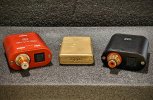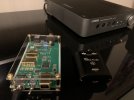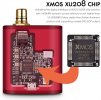PHIREE U2S 2019 & Douk Audio U2 Review and Measurements
(Digital USB to S/PDIF Interfaces)
(Digital USB to S/PDIF Interfaces)
Update March 2022: Added comparison with the Douk Audio U2.
Here is a quick review of the PHIREE U2S 2019 digital interface. This is basically some USB to S/PDIF converter that allows you to get USB playback from either your computer or smartphone, to many integrated amplifiers, streamers or DACs which usually have Coaxial/Toslink inputs only. I have noticed a strong demand for this kind of products and it is often the one I recommend, considering its cheap price. I bought mine 36.90€ VAT inc. from @Audiophonics. I do not see many others retailers for PHIREE apart from few store on eBay or AliExpress.
Not a lot of features to cover here : The U2S is based on the Bravo SA9023 chip and does support PCM up to 24 Bits / 96Khz (who would need more anyway?Connectivity is only S/PDIF, with both Coaxial and Optical outputs on one end:
And Micro-B USB input on the other:
In case you are wondering: 1) Both Coax and Optical outputs are working in the same time. 2) The U2S is self-powered by USB (1 meter cable supplied). It works as a simple plug and play unit, with no on/off switch, nor LED. Some will like this being driver-free. Personally, I would have preferred a dedicated USB driver supporting ASIO. I worked flawless and stable using WASAPI when bitperfect was needed, tho.
Speaking of which, I used the Bit Test provided by @MC_RME and I played it with Foobar. It worked as intended with every sampling rates from 44.1Khz to 96Hkhz:
Speaking of which, I used the Bit Test provided by @MC_RME and I played it with Foobar. It worked as intended with every sampling rates from 44.1Khz to 96Hkhz:
Obviously, the test stopped when hitting 192Khz, unsupported by the U2S:
For music playback, I was pleased to see Roon doing a great job to deal with that limitation, using some downsampling to 96Khz :
Sound impressions worth nothing to write anything about. I simply could not hear any difference between the U2S being plugged (to S/PDIF inputs of my DAC), and the regular way I'm familiar with (PC straight to DAC USB input). Period.
On a more practical side, I did not notice any dropout, crash or anything when listening to music (Roon), using Chrome browser for YouTube, playing few video games, watching some movies with VLC and so on. The only issue I have to report occurred with the Netflix Windows client, when sometimes the sound got completely muted while launching the app. I managed to fix this by setting the sound playback from 5.1 to 2.0 channels. I did not test the U2S paired with my Android phone and UAPP yet, since I must find my OTG cable first...
On a more practical side, I did not notice any dropout, crash or anything when listening to music (Roon), using Chrome browser for YouTube, playing few video games, watching some movies with VLC and so on. The only issue I have to report occurred with the Netflix Windows client, when sometimes the sound got completely muted while launching the app. I managed to fix this by setting the sound playback from 5.1 to 2.0 channels. I did not test the U2S paired with my Android phone and UAPP yet, since I must find my OTG cable first...
Measurements
I may only provide kind of amateurish measurements with my means, though I spent a lot of time to be ensured about their repeatability. For reference, I used my daily DAC, the Matrix Mini-i Pro 3. We are trying to find out if the PHIREE U2S brings any kind of degradation over the regular USB input of the Mini-i Pro 3. For that purpose, I used my E1DA Cosmos ADC (SOTA performer). On the software side : the good old RightMark Audio Analyzer PRO and the great Multitone Analyzer from @pkane. What gets measured is the fixed XLR output of the Matrix DAC, to the Cosmos ADC (set to 4.5Vrms). For better accuracy, each individual result is the median of 8 captures. Main limitation : I did not find a reliable way to measure Jitter. (Edit : Add J-Test for both Douk U2 and PHIREE U2S)
I compared these three usage scenarios :
1) PC -> USB -> DAC USB input (reference).
2) PC -> USB -> PHIREE U2S -> DAC Optical input.
3) PC -> USB -> PHIREE U2S -> DAC Coaxial input.
All tests are set with 24 bits / 44.1Khz.
RMAA Summary
| Test | PHIREE U2S Optical | PHIREE U2S Coaxial | Matrix USB ASIO |
Frequency response (from 40 Hz to 15 kHz), dB | +0.05, -0.39 | +0.05, -0.39 | +0.01, -0.03 |
Noise level, dB (A) | -121.1 | -121.1 | -123.1 |
Dynamic range, dB (A) | 120.7 | 120.9 | 122.9 |
THD, % | 0.00024 | 0.00024 | 0.00029 |
IMD + Noise, % | 0.00046 | 0.00045 | 0.00046 |
Stereo crosstalk, dB | -120.7 | -121.1 | -122.5 |
THD + Noise (-3dBFS)
Frequency response
Noise Level
Dynamic Range
Crosstalk
Intermodulation distortion + Noise
Intermodulation distortion (swept tones)
No need to mention, Optical and Coaxial offer identical results. Worst case scenario against ASIO USB is the loss of barely ≈2dB with Noise, DR and Crosstalk. Performance is basically 99% the same on whatever test, with the exception of frequency response. I cannot be sure where this 0.5dB drop is coming from. My guess is some filtering due to DirectSound (I cannot run WASAPI with RMAA), since this variation does not occur when using other softwares, and where both U2S and Matrix USB are set with WASAPI. Second hypothesis, it could be directly the S/PDIF behaviour from the DAC itself (edit: see below, with the addition of the Douk Audio U2).
To make sure about that, I tested it against my PC toslink output :
Exactly the same results when looking at the FR... In fact, the PHIREE U2S did way better in other tests. The Realtek Digital Ouput of the motherboard showed repeatable mismatch between harmonics (and more distortion), that were not there using the U2S :
Multitone Analyzer (100 tones, 5 averages)
Matrix direct USB
PHIREE U2S Coaxial
PHIREE U2S Optical
Long story short : No audible difference whatsoever.
Jitter
Thanks again to @pkane, I can now run J-Tests via Multitone. Here both DAC and ADC are set to 48Khz, and measured within 1Khz-24Khz bandwidth, 131k FFT, and 16 averages. What you see is the result zoomed-ind around the 12Khz tone.
Matrix direct USB
PHIREE U2S Optical
Douk Audio U2 (update)
It is now time for a short update of the original review, with the addition of the Douk Audio U2 I bought since. It is a very similar unit, if not identical, sharing the same aluminium case and connectivity. MSRP is 69.99$, so quite a few bit pricer than the PHIREE, but I saw a lot of deals for it. For example, it is actually sold for 48.60€ at AliExpress, with both Red or Black finishes.
As you can see, both look very much like twin brothers. Except they are not : The Douk Audio U2 uses XMOS XU208 chip and does support ASIO drivers. About that : the USB driver comes on some mini CD-ROM supplied in the box. Since I stopped using optical drives for a while, I had to manually enter the Google Drive URL written in the manual, which was... a dead link. I mailed Douk Audio and got a very fast reply with the updated link. For the record, you may find it there.
Contrary to the PHIREE, 192Khz is natively supported. It also claims to be suitable for DSD64 (DoP).
According to this short teardown, the Douk U2 gives you a lot more components for the money...
Measurements
This part will be much shorter than above, since both units performed 90% the same in all tests.
RMAA Summary
| Test | PHIREE U2S Optical | Douk Audio U2 Optical |
Frequency response (from 40 Hz to 15 kHz), dB | +0.05, -0.39 | +0.01, -0.06 |
Noise level, dB (A) | -121.1 | -121.0 |
Dynamic range, dB (A) | 120.7 | 120.8 |
THD, % | 0.00024 | 0.00024 |
IMD + Noise, % | 0.00046 | 0.00046 |
Stereo crosstalk, dB | -120.7 | -121.4 |
Why "90%"? Because the frequency response is without a doubt not as altered as it was with the PHIREE. It is still 0.03dB lower at 15Khz when comparing to the USB input of the Matrix (ASIO). Note that I had to run tests with DirectSound again, because for some reason I wasn't able to start measurements with ASIO in RMAA... Douk Audio's ASIO driver worked OK with either Roon or Foobar, on the other hand.
Frequency response
Good news, the drop is (almost) gone ! So it was not related to either S/PDIF inputs of the Matrix, nor DirectSound. Would the PHIREE U2S get rid of this drop with some specific driver? No way to be sure. Until something new comes out, the Douk Audio does have an obvious advantage here. I will keep it as a reference for measurements.
Jitter (Optical)

A bit much of side peaks around the 12Khz tone, but all are at worst 135dB+ lower than the main signal. So there should hardly be any audible concern.
Conclusions
Well... in a perfect world, "Digital should be digital", right? Yet, we have seen many cases of performance degradation in the analog domain (most often: barely audible, if any) introduced by bad S/PDIF or USB decoding. This is a niche market where some manufactures may ask hundreds of €/$ for their "audiophile" digital interfaces, claiming either about their perfect transparency or sound improvements.
Most measurements here do show close to perfectly transparent solutions, that do not differ from regular performance of my DAC using USB. With either the PHIREE U2S or the Douk Audio U2, you get what you pay for : USB playback to your S/PDIF inputs. Nothing more nor less. With this review now updated, I have to pause my unconditional recommendation for the PHIREE, based on what I found in measurements of frequency response compared to the Douk Audio U2. Turns out that the Douk Audio is transparent, while the PHIREE... not quite. Is 0.5dB drop at 17Khz an audible issue? Not to me. I spent days listening to music with it and did not bother at all. From a more technical standpoint tho, I give my highest recommendation to the Douk Audio U2, for which the additional cost makes sense.
Most measurements here do show close to perfectly transparent solutions, that do not differ from regular performance of my DAC using USB. With either the PHIREE U2S or the Douk Audio U2, you get what you pay for : USB playback to your S/PDIF inputs. Nothing more nor less. With this review now updated, I have to pause my unconditional recommendation for the PHIREE, based on what I found in measurements of frequency response compared to the Douk Audio U2. Turns out that the Douk Audio is transparent, while the PHIREE... not quite. Is 0.5dB drop at 17Khz an audible issue? Not to me. I spent days listening to music with it and did not bother at all. From a more technical standpoint tho, I give my highest recommendation to the Douk Audio U2, for which the additional cost makes sense.
Last edited:





